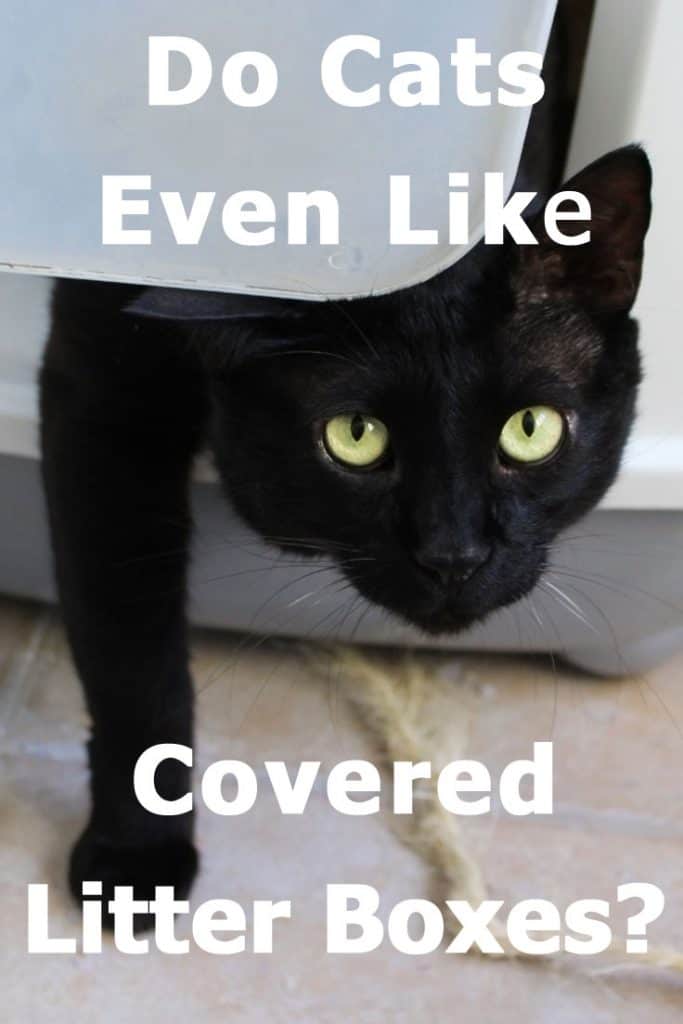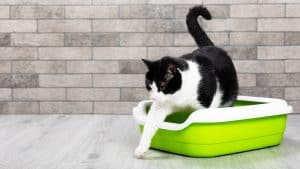To cover or not to cover, that is the question. And we're talking about placing a hood over your cat's litter box, not about covering up "the produce" in the box. When buying a new litter box, many owners wonder whether to get an open model or one that has a hood to it. Let's discuss covered litter boxes vs. open ones and see which works best. We even have a scientific answer to the everlasting question: Do cats like covered litter boxes. Stick around as we share everything there is to know about the covered litter box issue.
What Are Covered Litter Boxes?
What Do the Names Mean?
Covered or hooded litter boxes refer to a litter box that has sides as well as a roof. There is a flap door that the cat can enter to do their business and then exit when they’re done. If you want, you can always remove this door. Many covered litter boxes also feature sizeable holes throughout. These provide aeration so the waste in the litter box doesn’t start to smell before you get the chance to clean it up.
Most covered litter boxes have a hard-plastic shell. They may be rounded at the top (dome-like) or have square edges. These boxes are quite durable and less likely to bend or crack compared to standard litter boxes without covers. Another benefit of this type of litter box is that cats are less likely to bring large quantities of litter out with them. If you’ve ever had to vacuum up cat litter from hard flooring or carpeting before, you know how annoying this can be. Having less litter on the floor is always welcome.
To change the litter, you often have to take off the top tray or the front door of the box. You can then reach in and scoop up poops, gather up dirty litter, or pour in fresh litter. While it’s a little harder to reach into a covered litter box than an open one, the other benefits of these boxes make them a trusted choice for many cat owners.
Are There Any Differences Between Hooded and Covered Litter Boxes?
Whether you prefer to call them hooded litter boxes or covered litter boxes, the two terms are referring to the same type of box. The names are essentially interchangeable, so if you’re shopping around online or at a pet store for one of these litter boxes, don’t be surprised if you see either name.
Catit calls this model a hooded litter box. As you can see, this is a covered litter box too.
That said, hooded/covered litter boxes are not the same as top-entry litter boxes. While these too have a top door, that is their most defining characteristic. The door is designed for the cat to jump on top of and then do its business. You still put a litter tray in there, which can be accessed via the removable top cover. Cats are less likely to make a mess on the litter box walls.
Unlike hooded and covered litter boxes, there is no front entry door. This keeps children and pets away from the litter box. Of course, if a cat is overweight or old, they will not have the dexterity required for one of these boxes.
Why Do People Choose Covered Litter Boxes?
Keeping Litter out of Sight
There are plenty of reasons a cat owner might choose a covered litter box. One of the biggest of those reasons is to keep litter out of their line of sight. No matter how much you love your cat, you know that a litter box is unappealing to have around the house. You can get a pretty one that’s designed to blend in with home décor, but at the end of the day, this is your cat’s toilet, and no one wants to see it.
That’s why there are so many more creative litter box options on the market today. If you wanted, you could get litter box enclosures that look like cabinets, end tables, desks, nightstands, and more. The cat enters through a door, which can be closed when the cat isn’t in there. Of course, these types of litter boxes are quite expensive. Also, as pretty as they are, they’re still litter boxes.
A covered or hooded litter box is another way to eliminate the problem of having to look at litter as well as a cat’s business. You can simply push the box in a corner somewhere with minimal foot traffic and hope no one sees it.
Reducing Litter Box Odors
Whew! Can you smell that? You’re probably used to urine or feces stenches wafting in after your cat does their thing in their litter box. Unfortunately, cat urine is notoriously noxious thanks to its high quantities of a metabolic compound called urea. People have urea, too, but we flush the toilet when we’re done going to the bathroom. Cats don’t have that luxury.
There’s ammonia and other chemicals in urea that is released with time, leading to that nose-pinching, unappealing stench. It’s even worse when combined with the smell of old litter as well as pheromones and even cat feces. Speaking of cat feces, whether this is fresh or a few hours old, it’s absolutely nausea-inducing if you have to breathe it in for a while.
While neither cat urine nor cat feces are toxic per se, it’s still not healthy to be in an environment with this waste. Do know that if you don’t thoroughly clean your cat’s litter box (and we’re talking the box itself, not just taking out the dirty litter), the smells can linger. With the enclosed sides and roof of a covered litter box, though, it is possible to control the smell of cat waste a little better.
But is that really a good thing?
There's one caveat - and it's a super important one! When you're keeping the stench inside the covered litter box, it means Kitty will have to use an extra smelly bathroom. That's no fun at all and some cats decide to find alternative locations to do their business.
We'll talk about this some more later on, when discussing covered litter boxes from the feline perspective.
Providing a Sense of Privacy to the Cat (... Or Not?)
How often does your cat wander into the bathroom when you’re using it? Maybe they poke their head in the shower or come into the bedroom when you’re getting changed. You probably feel like your cat has no shame. They’re not exactly embarrassed about watching you go about your daily routine, and they don’t seem to care much if you watch them go about theirs, either.
According to certified cat behavior consultant Marilyn Krieger, cats “are not into the privacy thing, either. People are.” It appears then that we as people have taken our own needs for privacy in the bathroom and projected them onto our feline friends. That’s probably part of why so many pet owners prefer covered litter boxes over open ones. They don’t want to disrupt their cat in the middle of their business. With a covered box, that risk is reduced.
Are there some cats that probably prefer an enclosed environment to make their business over an open one? Yes. It’s certainly not a necessity, though. In fact, as we’re going to discuss, what’s much more important for the cat is making sure they can get in and out of the litter box and don’t feel trapped.
 Covered Litter Boxes: The Cat’s Point of View
Covered Litter Boxes: The Cat’s Point of View
Why Cleaning Is Still Important
You know the old saying, “out of sight, out of mind,” right? It can be easy to take that approach with your cat’s litter box without even knowing it. If you don’t see the box because it’s covered or well-hidden (or because it looks like a curio cabinet), then it might not cross your mind to clean it until it starts getting really stinky. You should change the box at least twice daily, sometimes more and sometimes less depending on how many litter boxes and cats you have. That’s regardless if you have a covered litter box or an open one.
Another issue with pushing the cat’s litter box somewhere hidden is that the cat themselves may not be able to find it or access it. If the box is lodged into a corner or somewhere very high up, this is a disservice to the cat. They need to feel secure in where they do their business. If they don’t, they simply won’t use the litter box, which can lead to stinky, messy accidents. Make sure your cat can get to their box.
If you’re diligent about cleaning and conscientious of your cat’s needs, then you should be able to avoid having your home smell like cat waste. Remember, your cat might not want to use the litter box if it’s too filthy. To keep it clean and handy for them, ensure that the box is out of sight but not too out of sight that you forget about it.
Dealing with a Kitty That Feels Trapped
Cats often enjoy contorting themselves to fit into the smallest spaces possible, such as boots, bowls, in between couch cushions, and everywhere else they can squeeze their fuzzy bodies in. While they’re not claustrophobic, per se, that doesn’t mean they will be happy in every litter box.
Pam Johnson-Bennett is another cat behavior expert who says cats can feel trapped in top-entry and covered litter boxes. “When a cat needs to eliminate, the area she chooses should afford her safety and escape potential,” Bennett says. “If the cats lives in a multipet home…the need for escape becomes even more crucial. Adequate warning to see an approaching opponent, as well as more than one exit route must be factored in when deciding on the type of box to buy.”
A cat that feels like they can’t use their litter box due to the above risks might start making messes in the rest of the home, which, as we’ve discussed, is not fun for you or them. You might want to switch to a standard litter box if your cat has become apprehensive about doing their business in a covered litter box.
Is the Box Too Small? How to Tell
If you have a healthy, happy cat, then they should have no problems fitting into either a standard or a covered litter box. Even in kittenhood, many cats are growing and becoming curious and eager to explore the big world around them. That means they should be able to reach a covered litter box with ease. Bigger breeds or overweight cats might pose a problem, though.
To ensure your cat will fit in their litter box, measure the cat’s length and then get a box that’s at least one and a half times larger than that. It's always better to get a bigger litter box than a smaller one. Even if your cat doesn’t grow any bigger than what they are now, they’ll have more space to maneuver around. Marilyn Krieger, who was cited above, says a box should have a height of about 12 inches and be able to hold 66 quarts.
If your cat is struggling to get in and out of their litter box, then you know it’s too small for them. They may also make sounds when in or around the box to express their discomfort. At this point, you should size up so they can take care of their business happily.
So, Do Cats Like Covered Litter Boxes?
The Definitive Answer
It’s time to answer the question you’ve been wondering all along: do cats like covered litter boxes more than their open counterparts? While covered litter boxes certainly have their drawbacks (space issues, unnecessary privacy, the potential to feel trapped), many cats use them.
Let’s look at some interesting data. Here’s a study from the Journal of Feline Medicine and Surgery that was done with the Ross University School of Medicine and posted in spring 2013. Researchers were focused on perichezia and periuria, also known as feline inappropriate elimination, and how this could be treated.
While it was assumed that covered litter boxes could worsen feline inappropriate elimination, the researchers included these boxes in their study (as well as standard open litter boxes). They wanted to know which one cats liked more. Over two weeks, 28 cats participated in the study, making waste in both litter boxes. Besides testing the frequency of use, the researchers also studied weight waste and amount.
What was the result? Most of the cats (70 percent) didn’t seem to like one box more than the other. The remaining 30 percent were divided, with four cats using the uncovered litter box more and the other four cats using the covered box more. The researchers themselves concluded that “if boxes are kept sufficiently clean (i.e., once daily minimum cleaning), most cats will not show a preference for either box type.”
What does it all mean for you and your cat?
It may just be a single study but it did prove what many experienced owners already knew. The answer to the question "Do cats like covered litter boxes?" is: Some do and some don't and some just couldn't care less.
If you're adopting a new cat, it's best to offer two litter boxes anyway, so why not make one of them a covered box and the other a regular open box? That way you can see if your own cat has a preference and adjust accordingly.
If your Kitty has always been using a covered litter box without a problem, that's great. As long as you make sure to clean the box frequently, you're good to go. However, if your cat is having litter box accidents, it's probably a good idea to take the lid off the box and see if this makes it more attractive.




